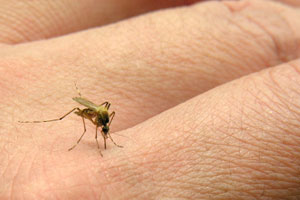MURRAY Valley encephalitis virus cases re-emerged in south-eastern Australia last year, with potential for further outbreaks this summer, following a dramatic rise in virus activity in endemic regions.
An online-first article from the MJA says the re-emergence of the virus in the south-east followed significant regional flooding and increased numbers of the main mosquito vector, Culex annulirostris. (1)
The last major outbreak of the virus in Australia occurred nearly 40 years ago.
The MJA article, by Dr James Knox of the Victorian Infectious Diseases Service and coauthors, said that in 2011 there were 16 confirmed human cases of the Murray Valley encephalitis virus (MVEV), including three deaths. The virus was geographically scattered, with cases reported in WA, NT, SA and NSW, plus an unconfirmed case in Victoria.
MVEV is fatal in 15%–30% of cases, with long-term neurological problems occurring in 30%–50% of survivors. Only about 40% recover completely. Despite the poor prognosis for people infected with the virus, diagnosis and treatment options remained limited.
“Recent circumstances remind us of the limited information we have about this disease … further research is needed to improve the capacity for early diagnosis, to identify effective treatment options and to improve preventive strategies”, the authors wrote.
Serological testing remains the mainstay of diagnosis; however, radiological imaging, particularly magnetic resonance imaging (MRI), can provide supportive information before serological results are available.
“Typical features [on MRI] include bilateral hyperintensity of the deep grey matter, especially the thalami, on fluid attenuation inversion recovery or T2-weighted images”, the authors wrote.
Cerebrospinal fluid findings in people infected with the virus are usually consistent with a viral meningoencephalitis, including raised protein concentration, normal glucose and a pleomorphic leukocytosis with a predominance of mononuclear cells.
With no therapeutic options of proven clinical value, treatment options are supportive only, the authors wrote.
“… we cannot currently recommend any specific antiviral therapy for infection with flavivirus encephalitides, including MVEV …”, the authors wrote, calling for further research.
They also said doctors should consider MVEV infection in patients with a suggestive clinical picture and who had been in regions of virus activity.
The MJA paper described a suspected case of the virus in Victoria last year, in which a 69-year-old man was thought to have had an ischaemic stroke and pneumonia, but suffered neurological progression until he was declared brain dead 10 days after admission.
Typical symptoms of infection include an incubation period of 1‒4 weeks, followed by a prodrome of 2‒5 days usually including fever (often >40ºC) and headache. Other prodromal features may include nausea, diarrhoea, vomiting, macular rash and cough.
Neurological features also occur early and may include lethargy, irritability, confusion and seizures.
The progression of neurological features varies. Some patients experience relentless progression to death, while others have encephalitis followed by a complete recovery.
“There are … no clearly defined features that predict subsequent clinical outcomes, although these appear to be worse in those with flaccid paralysis, and in the young or the elderly”, the authors wrote.
MVEV is a member of the Japanese encephalitis serological complex of flaviviruses. The last major outbreak of the virus in Australia was in 1974, when 58 cases were identified and the mortality rate was about 20%.
Last week, NSW Health issued a warning for people to protect themselves against mosquitoes after one person was diagnosed with MVEV and another contracted the Kunjin virus. (2)
– Sophie McNamara
1. MJA 2012; 23 January, online first
2. NSW Health media release; 18 January 2012
Posted 23 January 2012

 more_vert
more_vert
I have been retired for many years but I presume the flocks of “sentinal” chooks are maintained in the Riverina and other valley centres. Now that CDI is no longer published, it would be interesting to know what these poor birds are showing: is the data publicly available?